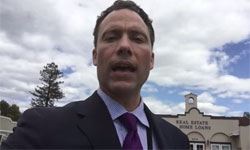We’re well past the stage where social media is just one extra thing reporters are being asked to squeeze into the finite amount of time they have before the top of the newscast. For multi-media journalists (MMJs) working without a videographer, shooting a selfie video to post on Twitter and Facebook is de rigueur, and, to be honest, should be required. Why would a TV station only post words when video is its currency?
This spring, during my annual trip to San Francisco to work for a couple of weeks as an MMJ at KPIX TV, I recorded my share of social media videos, promoting my stories for the 5 and 6 p.m. newscasts. The more of them I did, the more I realized shooting selfie videos for social media is a great way for my broadcast journalism students at Syracuse University to practice doing live shots.
Here are four things social media selfie videos and live shots have in common:
- They highlight the good stuff: Figuring out what to say in a social media selfie video requires the reporter to home in on the interesting aspects of the story. And that’s the key part – the interesting aspects of the story. The goal, after all, is to have the viewers who see the video say to themselves, “Wow! This is a story I don’t want to miss.” Promoting the mundane is pointless. The same goes for a live shot. While the reporter isn’t going to summarize the entire story in the live toss to the package, what the reporter should be doing is highlighting the element of the story that is most likely to get the viewers to stick around, so they do watch the package.
- They relate the story to the background: It’s a long-standing tenet of live TV that what the viewer hears should relate to what the viewer sees. That applies to social media video posts, too. Even though MMJs are shooting themselves with their mobile device, that’s no excuse not to give the viewers a combination of both audible and visual information. A good live shot does the same thing – it explains to the viewers why reporters are where they are. Answer that question right off the bat and the viewer can spend more brainpower listening to what else the reporter has to say.
- They include movement: Shooting a selfie with a mobile device is the epitome of video-graphic freedom. The reporter can decide, almost without limitation, what to show and how to reveal it. Moreover, the stabilization technology in newer smart phones means walking doesn’t necessarily produce shaking. Beginning reporters learning how to do live shots can apply the same mindset. Don’t just stand there. Show the viewers something; take them somewhere. It makes live shots more compelling.
- They encourage you to go scriptless and to keep it simple: Sure, MMJs might write down what they want to say in their selfie social media video ahead of time, but holding the phone with one hand makes it nearly impossible to hold the notepad in the other. To pull off a polished promotional social media selfie video, reporters need to keep it simple. Resist the urge to say more. In fact, the less you say, the more cogent your presentation will be. Which is precisely the way to do an accomplished live shot. Reporters might refer to notes in a live shot, but they certainly don’t read them. Think about the big points you want to make and then convey them conversationally, not in a scripted manner.
In previous reporting classes I’ve taught, students posted written Tweets throughout the day. When I return to the classroom this fall, I will require my broadcast reporting students to shoot at least one social media selfie video for each story they do. Because this class is also dedicated to live shot performance, I’m hoping the students will be able to kill two birds with one stone: get better at the selfies, see the results in the live shots.
Simon Perez is an assistant professor of broadcast and digital journalism at Syracuse University’s S.I. Newhouse School of Public Communications. In the summers of 2012, 2014 and 2015 he returned to his former job as reporter for KPIX TV in San Francisco. He has chronicled his newsroom experiences and the lessons he hopes to bring back to the classroom at http://www.simonperez.com/blog-1/.






